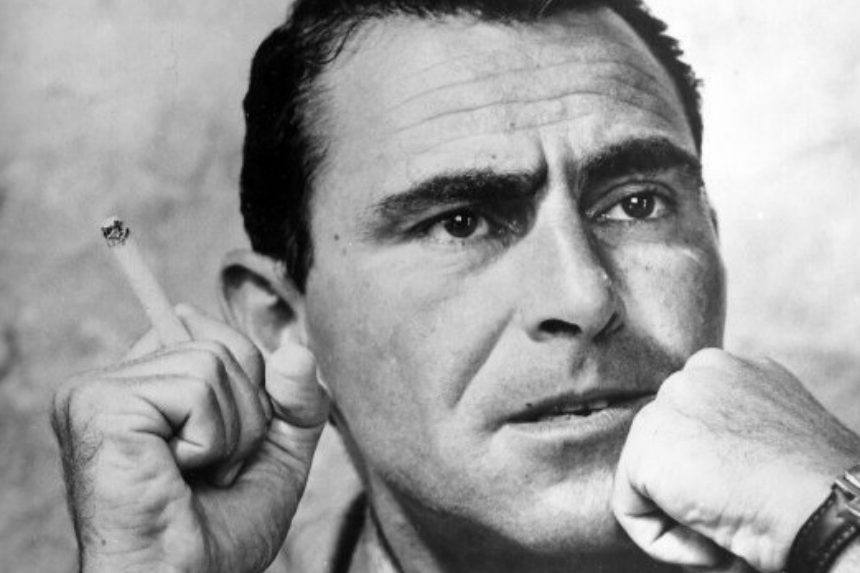
Ask any scriptwriter today to name a writer who influenced the way they draft their teleplays, and the name Rod Serling often comes up. A prolific contributor of fine dramas for almost every major prestigious live anthology series during the mid-’50s, Serling took his love of science fiction and fantasy to a new level when he gambled his own money to invest in a television program titled The Twilight Zone. The series ultimately changed the way science fiction was interpreted on TV. Scribe George Clayton Johnson characterized The Twilight Zone best when he referred to the series as “wisdom fiction.” Today, producers like J.J. Abrams and directors such as Steven Spielberg acknowledge Serling’s influence on their own productions.
A former boxer and paratrooper, Rod Serling worked first in radio and then moved on to television. Wanting to make a profession of writing, he listened to a lot of radio shows, often favoring good dramas, serious horror, and science fiction. Programs such as Quiet Please and The Mysterious Traveler influenced the types of stories he preferred. One of Serling’s earliest jobs was as an unsalaried volunteer writer and actor with WNYC, a New York City radio station. Later he worked for stations in Marion and Springfield, Ohio, as well as Cincinnati and his native Binghamton, New York.
Carol Serling, Rod’s wife, shared some of his thoughts with me. “It was experience,” he later recalled, “but incidental experience. I learned ‘time,’ writing for a medium that is measured in seconds. Radio and its offspring, television, are unique in the stringency of the time factor. Radio and TV stations gave me a look-see at the factory that would produce my product. I got to understand the basic workings of cameras, lights and microphones. I got a sense of the space that could be utilized and the number of people who might be accommodated in that space. This was all to the good.”
On the evening of January 12, 1955, Kraft Television Theater presented “Patterns,” his story of the clash between a decent but ambitious young man and an indecent older man in an industrial empire. It allowed for the possibility of dramatic conflict, psychological probing (not far removed from the surface), and rapid characterization. The teleplay would earn Serling his first Emmy award. A year later, Serling’s “Requiem for a Heavyweight” (telecast on Playhouse 90) won unanimously excellent reviews and gave the playwright his second Emmy award. Additional top honors came when he was bestowed the Sylvania Award for “Best Television Writing.”
Fearing dismal ratings with a science fiction anthology, and worried about losing Rod Serling as a staff writer for Playhouse 90, CBS agreed to give him a late-night time slot for Friday evening, a time slot initially considered a ratings killer in broadcasting circles. Thus The Twilight Zone was born and remains today as the standard against which all other science fiction programs are judged. Polls in TV Guide and various entertainment websites have listed The Twilight Zone as one of the top tprograms ever broadcast on network television.
Television viewers were treated to a weekly spectacle on The Twilight Zone through a variety of chilling stories. For instance, in “A Stop at Willoughby,” an advertising executive suffering from exhaustion travels home by train only to arrive in a mythical town complete with bandstand and bicycles, described as a place that is “peaceful, restful, and where a man can slow down to a walk and live his life to full measure.” At the conclusion of his adventure, the dead body of the executive is discovered. Willoughby is “wishful thinking nestled in a hidden part of a man’s mind.”
One of the most memorable episodes was “Time Enough at Last,” starring Burgess Meredith as a mousy bookworm named Henry Bemis who prefers to spend his time reading, against the wishes of his boss at the bank, his wife, and his friends. While spending the afternoon in the bank vault during his lunchtime, Bemis is shocked when he exits to discover an H-bomb devastated the entire area, and he is the only living soul left. Wandering amid the rubble for any sign of life, foraging for food, he begins to despair of his loneliness, even contemplating suicide, until he catches a glimpse of a library in the ruins. Bemis now has time enough at last to read to his heart’s content with nobody to badger him. But it’s all short-lived, for on top of a major tragedy comes a minor one: while reaching for a book, he stumbles over the ruins, causing his glasses to fall to the ground and shatter. Mr. Bemis is now blind as a bat.
Through The Twilight Zone, Serling became an iconic celebrity known to have a distinctive clipped manner of speaking. His stories often showed a dark side of humanity ruled by paranoia, hatred, prejudice, and ignorance. The Twilight Zone lasted five seasons, and television audiences were usually left with a sense of unease that was either relieved or exacerbated by the moral commentary provided by Serling himself during the closing narration. Carol Serling shared this quote with me: “With The Twilight Zone I have, with varying degrees of success or failure, attempted to touch upon moral themes utilizing the device of the parable,” Serling once explained. “In other words, I have tried to insert subtly what I hope to be a message, but couched it in such a manner that it becomes almost an unconscious effect. Hence, I will tell a story about an invasion from outer space, but tell it with an implicit suggestion that human beings are prone to inordinate suspicions and prejudices about things that are ‘different.'”
The Twilight Zone was also a showcase for rising stars who had yet to make their mark in Hollywood. Before her role as Catwoman in Batman, Julie Newmar played the role of a female devil who cons a greedy businessman. Before her role as Samantha Stephens on Bewitched, Elizabeth Montgomery played the role of the last female survivor of chemical warfare who has to find romance with the sole surviving enemy in an effort to repopulate the human race. Robert Redford played the role of Mr. Death, William Shatner witnessed a gremlin tearing an engine apart during mid-flight, and Peter Falk played the role of a Latin American liberator.
The series also spun off a plethora of merchandise including comic books, t-shirts, and board games. In 1994, 19 years after his death, The Twilight Zone Tower of Terror attraction opened at the Walt Disney-MGM Studios theme park in Orlando, Florida. Through the clever use of carefully edited footage and a Rod Serling sound-alike, the ride made fans of the television series scream as they plunged hundreds of feet to the ground while revisiting iconic props from the series. In 2009, the U.S. Post Office issued a commemorative stamp honoring The Twilight Zone, with Rod Serling pictured on the front. Recently, I had a part in transitioning The Twilight Zone to radio — a medium Rod Serling admitted was better than television — that includes both adaptations of the original teleplays and brand new stories. The Twilight Zone Radio Dramas are hosted by Stacy Keach with today’s stars in the lead roles.
Following The Twilight Zone, Rod Serling secured a half-hour weekly Western starring Lloyd Bridges, titled The Loner. Serling had tried to sell the series to film studios a few years prior, but received numerous rejections, including one from Desilu, who felt their own program, The Texan starring Rory Calhoun, was too similar. The Loner lasted one season and proved Serling could master social injustice with a six-shooter as well as a spaceship. In the fall of 1970, Serling returned to his roots with an off-the-wall supernatural anthology titled Night Gallery, telecast over NBC for three seasons. The weekly collection of supernatural vignettes included phantoms, witches, vampires, walking corpses, and spooky mysteries.
On June 27, 1975, Rod Serling suffered two severe heart attacks en route to Strong Memorial Hospital in Rochester, New York. During heart bypass surgery, he suffered a third heart attack and died the following day. He was just 50 years old.
Carl Amari is the host of the nationally-syndicated nostalgia radio series Hollywood 360. Amari is also the curator of The Classic Radio Club.
Featured image: Rod Serling (public domain, Wikimedia Commons)
Become a Saturday Evening Post member and enjoy unlimited access. Subscribe now




Comments
Serling is one of my big inspirations as a writer! Thanks for this! And I’ll recommend the TZ radio dramas!
“Ask any scriptwriter today to name a writer who influenced the way they draft their teleplays, and the name Rod Serling often comes up.”
Wouldn’t you have to ask more than one scriptwriter for his name to ‘often’ come up?